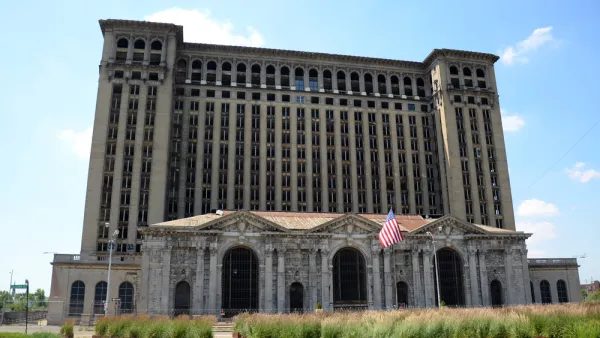In Detroit's downtown and midtown neighborhoods, 96 percent of rental apartments are occupied by young professionals, students and empty nesters. The city now faces the problem of meeting the high demand for urban living, reports Susan Stellin.
"The thriving apartment market in these neighborhoods is a bright spot in an otherwise grim financial picture for Detroit," says Stellin. "Once the nation's fourth-largest city, its population has dwindled and its finances are floundering." City officials have offered financial incentives for people to live and work in Detroit, young entrepreneurs and artists have contributed to the city's rebirth, and now the challenge is persuading "surburbanites to live closer to where they work and go out" and "figuring out how to reuse high-rise buildings and turn an area that once emptied out at night into a 24-hour community."
"A factor that has helped draw people to live in apartments either in midtown or downtown is up to $3,500 in rental rebates available to employees of companies like Quicken Loans and Blue Cross Blue Shield of Michigan," adds Stellin, "which have brought jobs back to Detroit." The city is also helping bring in amenities like bike paths, parks, and restaurants to attract prospective city dwellers. “This is truly a public-private sector driven strategy,” said George Jackson, president and chief executive of the Detroit Economic Growth Corporation. “What’s interesting is that the momentum and the partnerships are getting stronger even in light of the city’s financial situation.”
Developers could help meet expected housing demand by taking advantage of tax credits available for renovating historic buildings, but "a crucial factor is creating the thriving neighborhood hubs that places like San Francisco and New York have long offered." There is a 10-block gap between midtown and downtown "where the urban fabric drops off," said David Di Rita, a principal at the Roxbury Group. He acknowledged that the "area is gradually filling in," but pointed out that "much of the city was still struggling with empty buildings and abandoned single-family homes."
FULL STORY: New Thirst for Urban Living, and Few Detroit Rentals

National Parks Layoffs Will Cause Communities to Lose Billions
Thousands of essential park workers were laid off this week, just before the busy spring break season.

Retro-silient?: America’s First “Eco-burb,” The Woodlands Turns 50
A master-planned community north of Houston offers lessons on green infrastructure and resilient design, but falls short of its founder’s lofty affordability and walkability goals.

Delivering for America Plan Will Downgrade Mail Service in at Least 49.5 Percent of Zip Codes
Republican and Democrat lawmakers criticize the plan for its disproportionate negative impact on rural communities.

Test News Post 1
This is a summary

Test News Headline 46
Test for the image on the front page.

Balancing Bombs and Butterflies: How the National Guard Protects a Rare Species
The National Guard at Fort Indiantown Gap uses GIS technology and land management strategies to balance military training with conservation efforts, ensuring the survival of the rare eastern regal fritillary butterfly.
Urban Design for Planners 1: Software Tools
This six-course series explores essential urban design concepts using open source software and equips planners with the tools they need to participate fully in the urban design process.
Planning for Universal Design
Learn the tools for implementing Universal Design in planning regulations.
EMC Planning Group, Inc.
Planetizen
Planetizen
Mpact (formerly Rail~Volution)
Great Falls Development Authority, Inc.
HUDs Office of Policy Development and Research
NYU Wagner Graduate School of Public Service




























